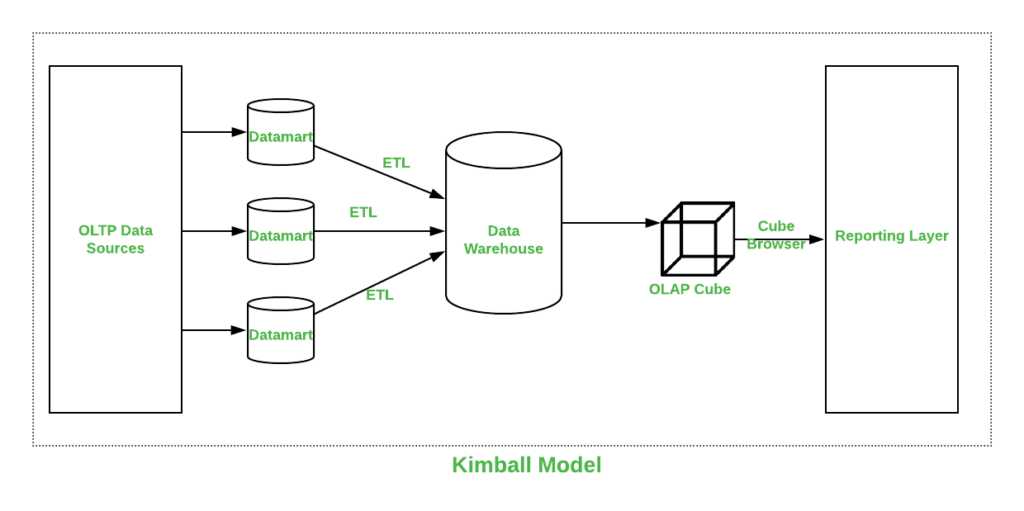When it comes to handling data, two big methods stand out: Kimball and Inmon. They both have their ways of setting up and running data warehouses, and each comes with its pros and cons. In this deep dive, we’ll break down these methods, looking at what makes them different and weighing the good and the bad to help you figure out which path to take in the world of data warehousing.
Understanding the Kimball Methodology
Ralph Kimball, a pioneer in the field of data warehousing, introduced a dimensional modeling approach that emphasizes simplicity, flexibility, and user accessibility. At the heart of the Kimball methodology lies the concept of the star schema, where data is organized into fact tables surrounded by dimension tables, forming a star-like structure. A lot of the time star models are loaded from a data vault model or a different historical layer. The storing of the data will not be done in the star models then, but a layer before this. With this extra layer, you can empty every fact and dimension table and load them in again. This is an approach a lot of companies tend to lean to.

Pros of the Kimball Approach:
- Ease of Understanding: The star schema is intuitive and easy for business users to comprehend, promoting faster adoption and utilization.
- Flexibility: Kimball’s approach allows for agile development and iterative enhancements, making it well-suited for dynamic business environments.
- Query Performance: With denormalized data structures, queries tend to perform well, optimizing analytical processing.
Cons of the Kimball Approach:
- Redundancy: Denormalization may lead to data redundancy, potentially increasing storage requirements.
- Limited Historical Analysis: Historical tracking can be challenging with the star schema, especially for slowly changing dimensions.
- Complex ETL Processes: Integrating data from disparate sources into the star schema can be complex and resource-intensive.
Unpacking the Inmon Methodology
Contrary to Kimball’s dimensional modeling, Bill Inmon advocates for a normalized approach focused on building a centralized data repository known as the enterprise data warehouse (EDW). In the Inmon methodology, data is organized into normalized tables, promoting data integrity and consistency across the organization. This centralized structure ensures that data is stored in a format optimized for relational database management systems, facilitating efficient querying and analysis. Additionally, the normalization process helps to reduce data redundancy and anomalies, enhancing overall data quality and reliability within the warehouse environment.

Pros of the Inmon Approach:
- Data Consistency: Normalization reduces data redundancy, ensuring consistency and accuracy throughout the warehouse.
- Scalability: The centralized EDW can scale to accommodate growing data volumes and evolving business needs.
- Comprehensive Data Integration: Inmon’s approach facilitates comprehensive data integration, providing a holistic view of organizational data assets.
Cons of the Inmon Approach:
- Complexity: The normalized structure can be complex, requiring a deep understanding of data relationships and dependencies.
- Performance Challenges: Join-heavy queries in a normalized schema may result in slower query performance compared to Kimball’s star schema.
- Longer Development Cycles: Building the EDW may involve longer development cycles and extensive upfront planning.
Conclusion: Choosing the Right Path
In the Kimball vs. Inmon debate, there’s no one-size-fits-all solution. The choice between these methodologies ultimately depends on your organization’s specific requirements, priorities, and constraints. While the Kimball approach prioritizes simplicity, flexibility, and user accessibility, the Inmon methodology emphasizes data integrity, consistency, and scalability.
When deciding between Kimball and Inmon, consider factors such as your organization’s data architecture, business goals, resource constraints, and long-term scalability needs. In some cases, a hybrid approach that combines elements of both methodologies may offer the best of both worlds, leveraging the strengths of each approach while mitigating their respective weaknesses.
In the dynamic landscape of data warehousing, adaptability and pragmatism are key. Whether you lean towards Kimball’s star schemas or Inmon’s centralized EDW, the ultimate goal remains the same: harnessing the power of data to drive informed decision-making and achieve strategic objectives in an ever-evolving digital era.





